Introduction
I recently came accross an r/space post, featuring a very interesting series of blog articles from Sean Raymond, astronomer at Bordeaux (France). The goal is simple : as an engineer of a very advanced civilization, to design a solar system that maximize the amount of habitable space, while remaining stable for billion years.
Working with published articles and an iterative improvements of the starting design, the author finally describes The Ultimate Engineered Solar System (UESS), which is well described in the following picture :

Principle is fairly simple : many planets share the same orbit, constituting a ring. This have been proved as stable in studies linked in the blog article series. By having multiple rings packed in the habitable zone, you get dozens of planets able to harbor life.
One another trick is to get rings rotating in opposite directions, to avoid too much gravity interferences, leading to system instability in no time.
When coming accross this, i wondered : how does it looks like, to inhabit this system ? Well, the obvious way to know it is to effectively build the system, and perform the necessary observations. Unfortunately, the current technological level of humanity does not allow us to perform this right now.
But there is an alternative way: do you know Space Engine ? It will help us to answer that question, without having to wait for technology improvements.
Space Engine
SE is a free proprietary software, simulating the known universe and beyond, and allowing the player to freely move around and on bodies, and to get astonishing views of another worlds. Note that SE is also a universe generator, because, beyond the official catalogs of systems that are rendered in the game, the engine use procedural generation to populate the places we do not know. And there is an incredible amount of them.
As such, SE is pretty much a very advanced wallpaper generator, you just have to look at the r/spaceengine community to get an idea of its capabilities (note: there is no such thing as playing it on your screen. Bonus point: wallpapers are tailored for your screen).
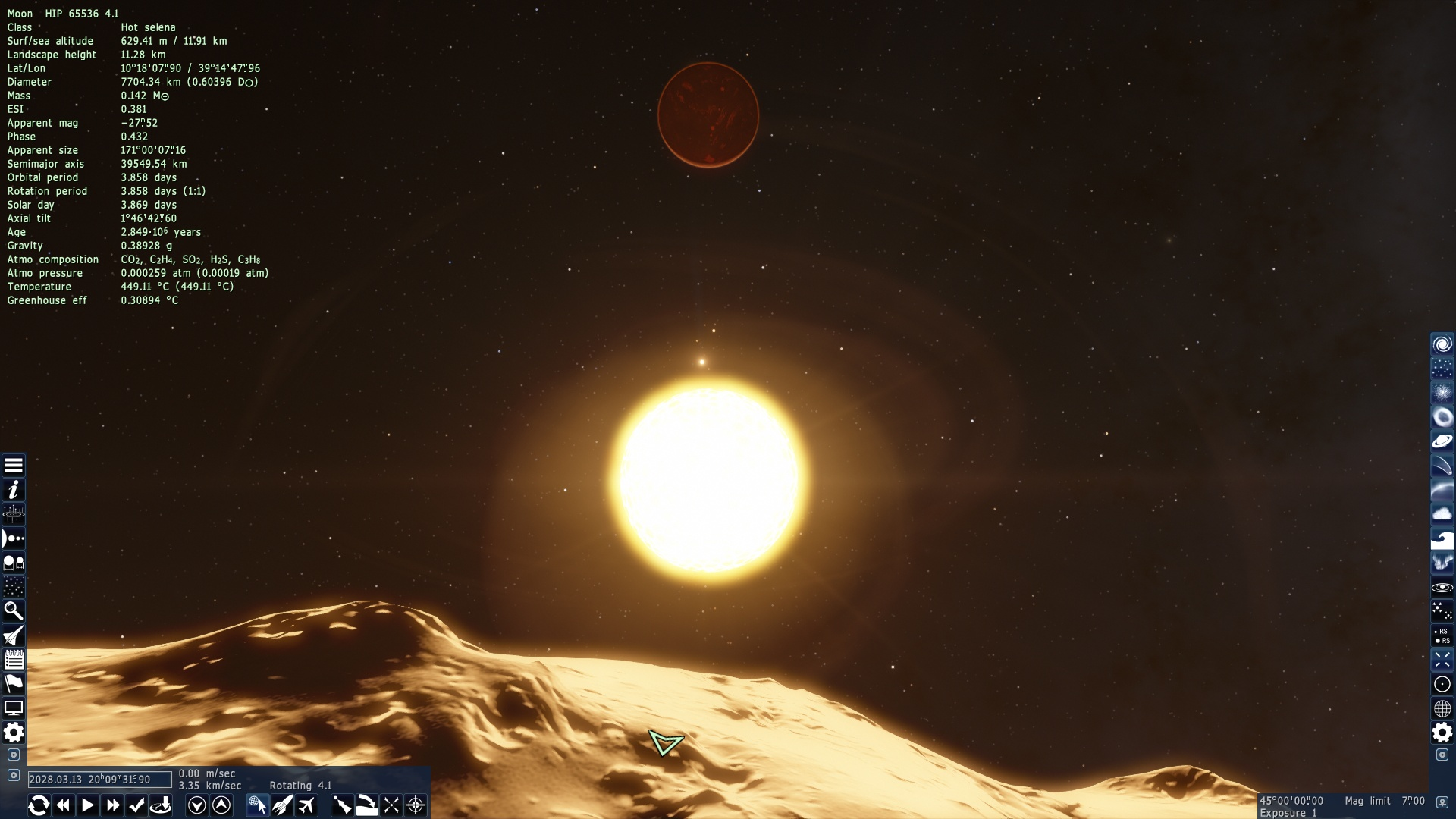
SE is a great visualization tool, that also provides… modding ! The direct consequence is that we can use this amazing software to modelize the UESS, and get views for anywhere, as if we were some inhabitants of one these worlds.
This blog post is an exploration of the modding side of Space Engine, which i learned to use while writing the post itself, and a search for generation of cool vantage points inside the UESS.
Generating a solar system
Space Engine provides a DSL to describes stars and planets. The star itself, named RS 1228-511-0-0-320, is made using the doc ; i didn't dig more about it. The system replace an existing one, in the Milky Way, not so far from the sun.
why ? Initially i did choose a star just above Andromeda, with a great view on it (and without planets in order to avoid an "i just destroyed a world for my own interest" moral crisis). However, for some reason, the star was ingame relocated in the milky way. I imagine it's because a missed a parameter in the star definition.
The star itself
Following the UESS description, i wrote the following definition for the star:
Remove "RS 1228-511-0-0-320"
Star "RS 1228-511-0-0-320/EngineeredSystemStar"
{
RA 16 10 45 // right ascension
Dec -25 12 11 // declination
Dist 100.0 // distance from the Sun
Class "G5V" // spectral class
Lum 0.50 // luminosity, or
RadSol 0.5 // radius in Solar radii
MassSol 0.5 // mass in Solar masses
Teff 5200 // surface temperature in Kelvin
NoPlanets true // avoid procedural generation ; we will populate it ourselves
}
This is a smaller-than-Sun star. The rationale is that smaller stars are more stable and live longer, but bigger stars offers more habitable space, so allow more planets. So this star, with its relative stability and its longevity, is the tradeoff considered in the UESS definition.
Planets
Sticking with the UESS, there is three examples of planet repartition, depending of their masses:
- 0.1 M⊕: 13 rings of 89 planets (marses).
- 1 M⊕: 6 rings of 42 planets (earth).
- 10 M⊕: 3 rings of 19 planets (super-earth).
Extensions of the three configurations
The following python code :
import pandas as pd
import matplotlib.pyplot as plt
plt.style.use('dark_background')
df = pd.DataFrame({
'mass': (0.1, 1, 10),
'planets': (1157, 252, 57),
'rings': (13, 6, 3),
'planets_per_ring': (89, 42, 19)
})
df.plot(x='mass', logx=True, logy=True)
plt.show()
Show us that the relation binding planet masses and number of planets, number of planets per ring and number of rings seems linear on a log-log axis :
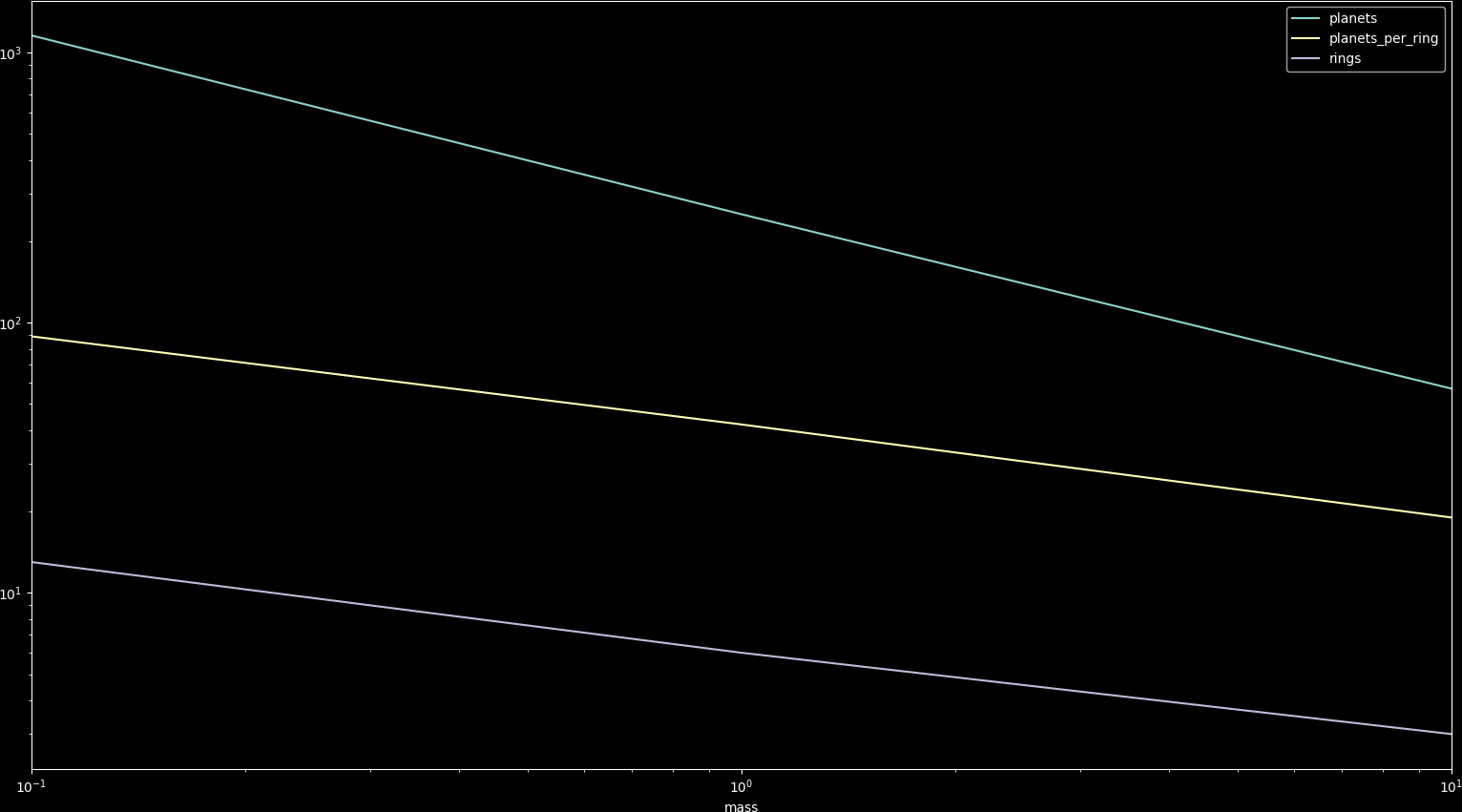
This suggests that we could choose any point on these lines to build a system with particular values, for instance, almost 185 planets of 1.618 M⊕ (the golden ratio). To get exactly 185 planets, we would need them to have a mass of 1.61412 M⊕.
The big thing is: taking the time to understand the calculations detailed in the papers will provide the equations necessary to compute the planet repartition knowing only a subset of the values (for instance, star habitable zone & planet masses could be enough). While this is the most generalist and exact way to go, for now, i will stick with the three given solutions.
Generating a planet
Using in-game search tool, i could find and export a terra-like planet hosting life in minutes. Not a very human-compliant one, but a one still. Follows the abbreviated version of the (long) export result.
There is many things in the planet definition, mainly about the planet in itself. Here, we will concentrate on the first lines (name, parent, other details) and the final block speaking of orbit itself. Space Engine will take care of parameters we do not submit (leading to a great diversity).
ParentBody "HIP 6694"
Class "Terra"
Mass 0.986073
Radius 6160.23
InertiaMoment 0.33103
Oblateness 0.00143271
RotationPeriod 34.9755
Obliquity -5.09689
EqAscendNode 98.9852
AlbedoBond 0.26
AlbedoGeom 0.312
Brightness 2
Color (0.612 0.501 0.457)
…
Orbit
{
RefPlane "Equator"
SemiMajorAxis 0.372917
Period 0.27011
Eccentricity 0.035495
Inclination -1.33857
AscendingNode 99.2429
ArgOfPericenter 229.944
MeanAnomaly 200.939
}
Well, only few of them are relevant in our case: for a given ring (set of planet sharing the same orbit), we only need the distance to the star (semimajoraxis in case of circular orbit… which is our case). Inclination, eccentricity and other parameters are generally set to 0.
But, by having 42 planets with the same orbit will end up in… 42 planets exactly at the same place in the simulated universe.
SE do not modelize collisions, nor detect that user wants to have planets evenly placed on one orbit.
The solution here is the MeanAnomaly, that is basically the start position of the planet in the orbit,
as an angle with the semi-major axis. Intuitively, if you have N planets, you need to place them each 360/N degrees on the ring.
Generating all planets
Once this is tested with two planets, let's face a brutal reality: no, i'm not gonna write all these planets myself.
You can find the python script i wrote in the project repository. In early version, the main parameters was only the number of planets per ring, and the number of ring. I soon added details, like planets masses, color randomization, variable ring angle,…
Note that, to get a body to orbit in reverse direction (needed by UESS to maintain stability), the trick is to gives a 180° inclination.
Visualizations of another world
Well, that's the part with pictures taken from the game itself.
Space Engine detail
To avoid crashing problems because of too many objects to show, i had to set the ressource loading method to interleaved, which is slow, but does not crash.
The missing piece
It is possible to get 4K screenshots on Space Engine. As i'm not on windows, so i didn't really dig about it.
Wallpapers generation
Follows some screenshots i taked, with their corresponding description.
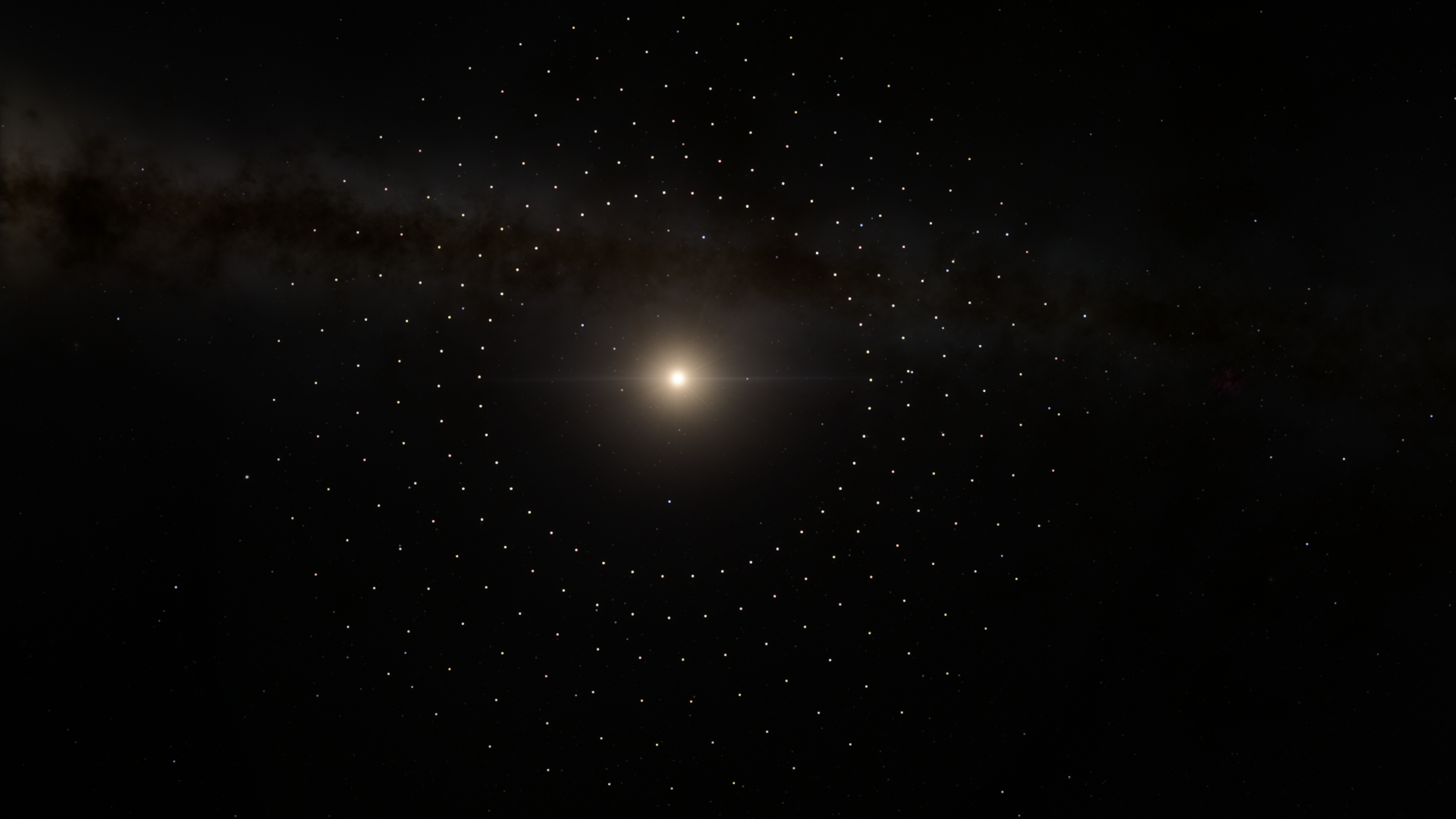
earth-like --ring-gap=0.2
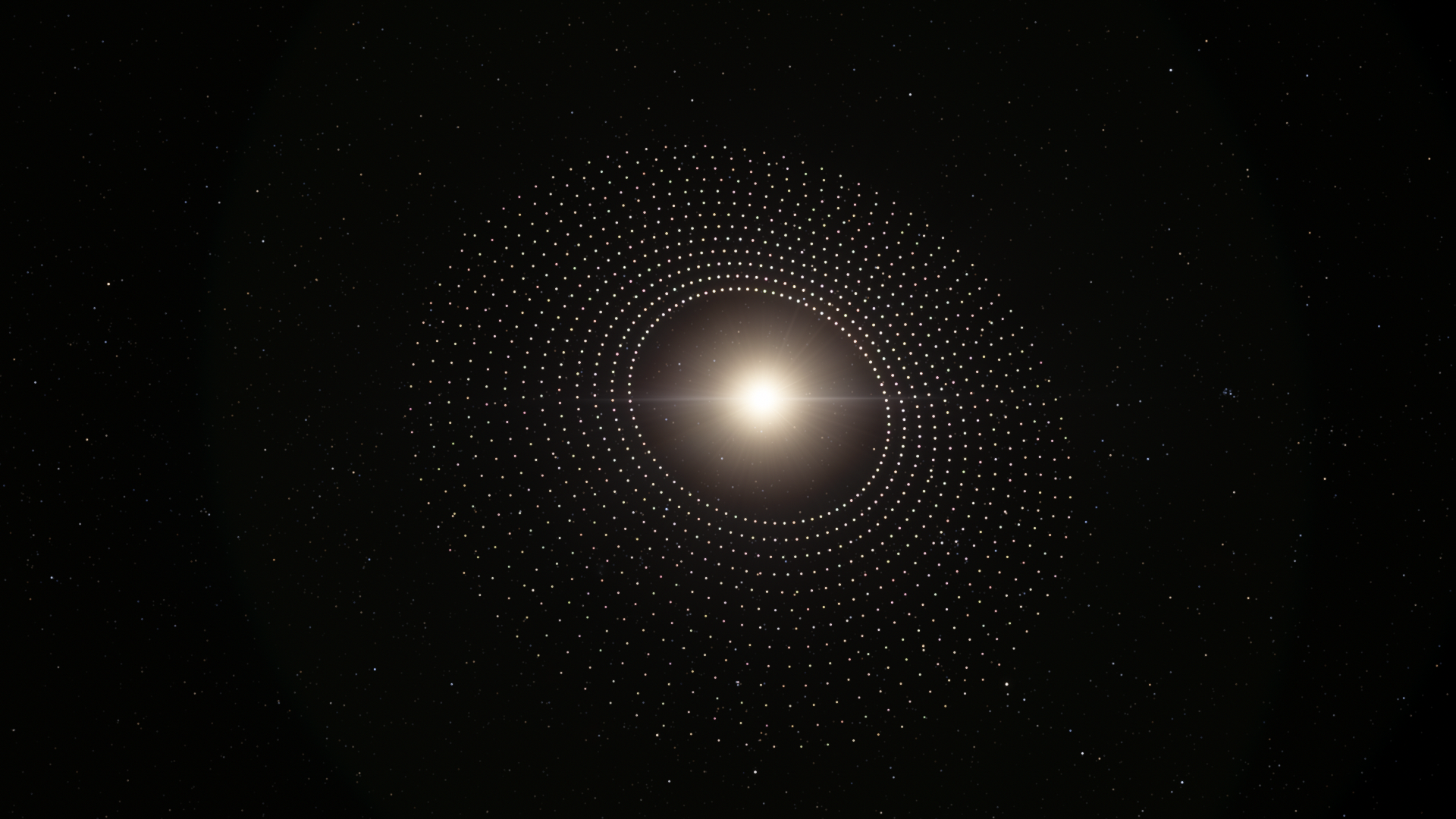
small-earth --ring-gap=0.2
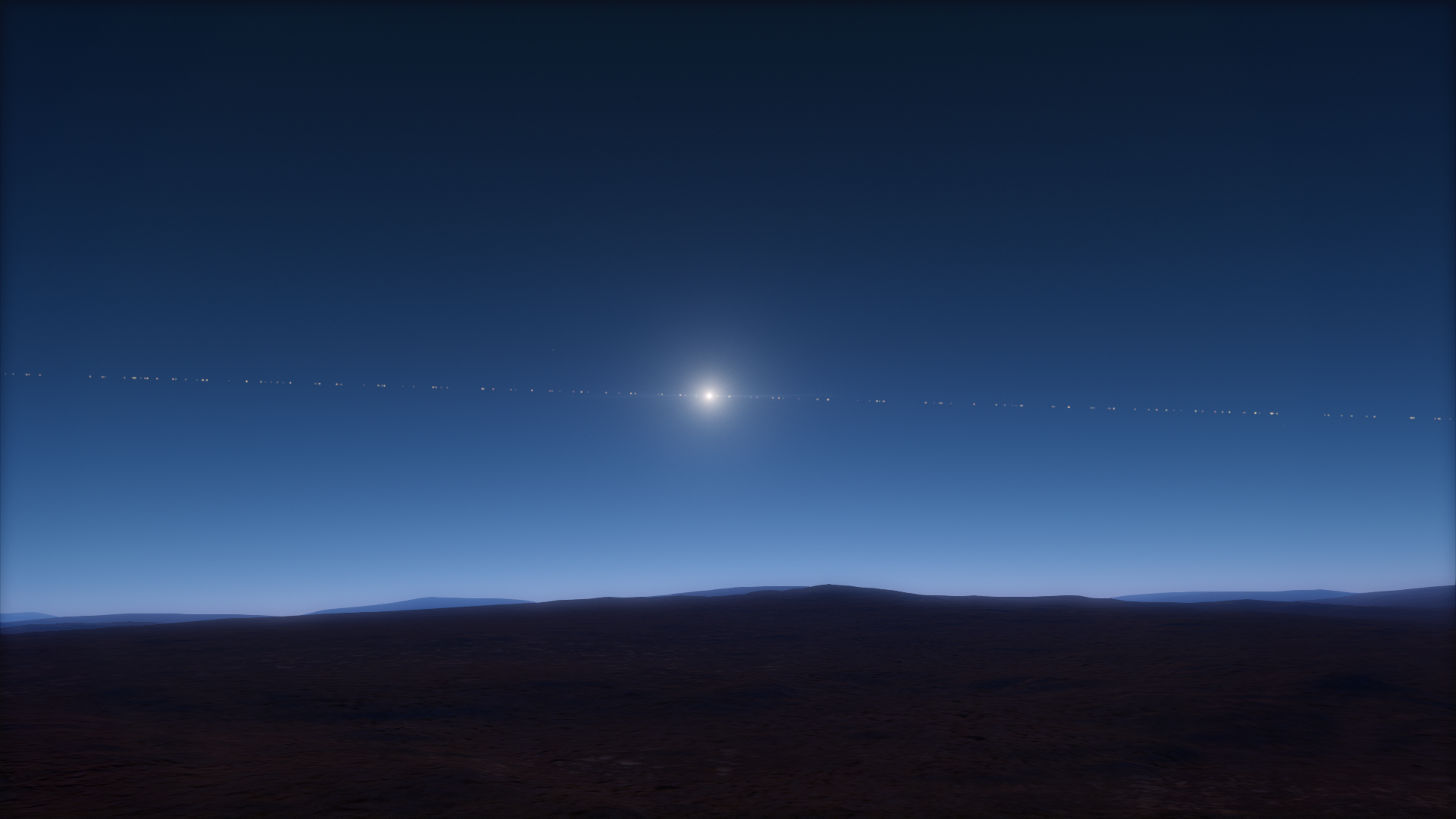
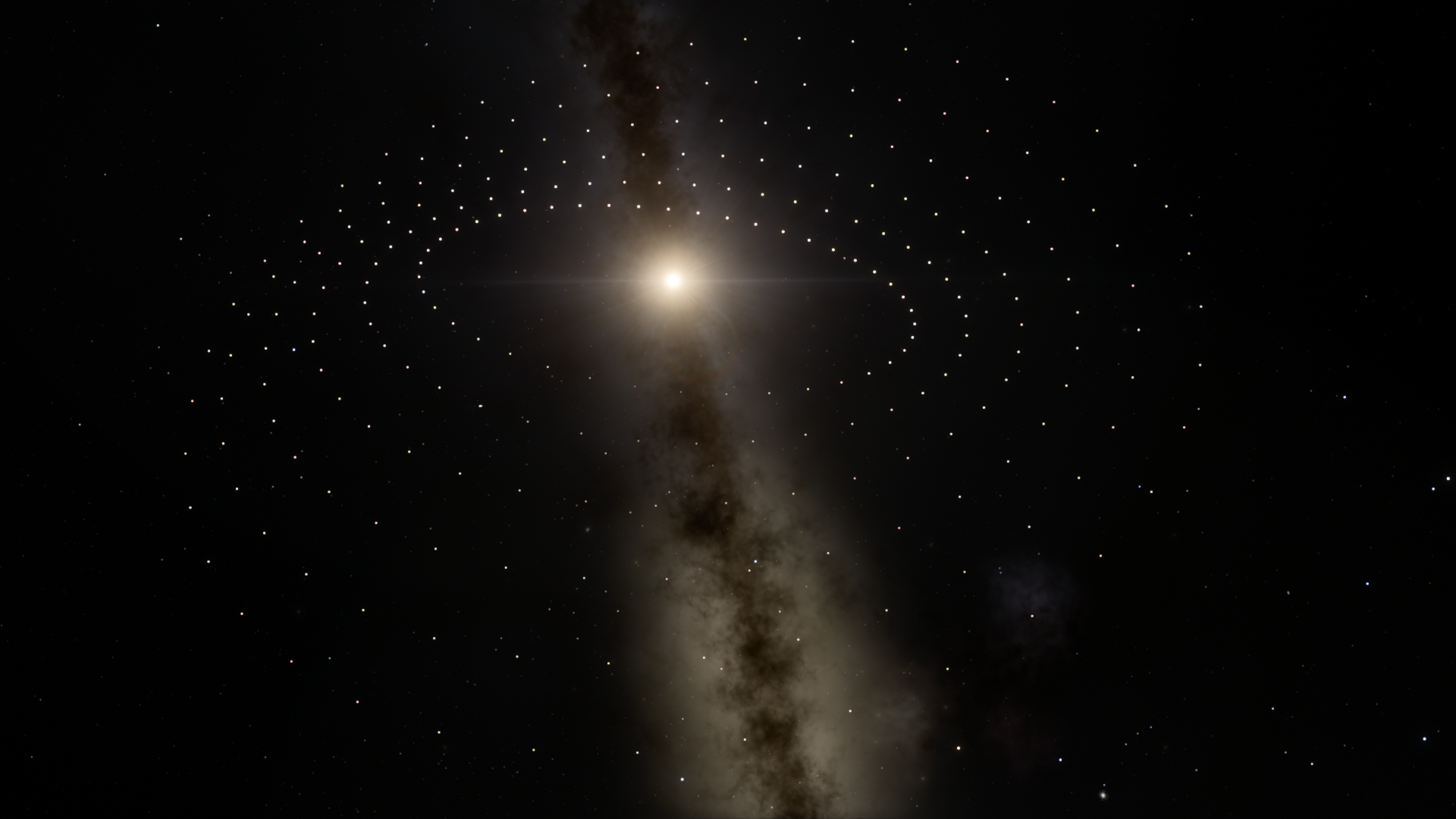
earth-like --ring-gap=0.2 --inclination-delta=5
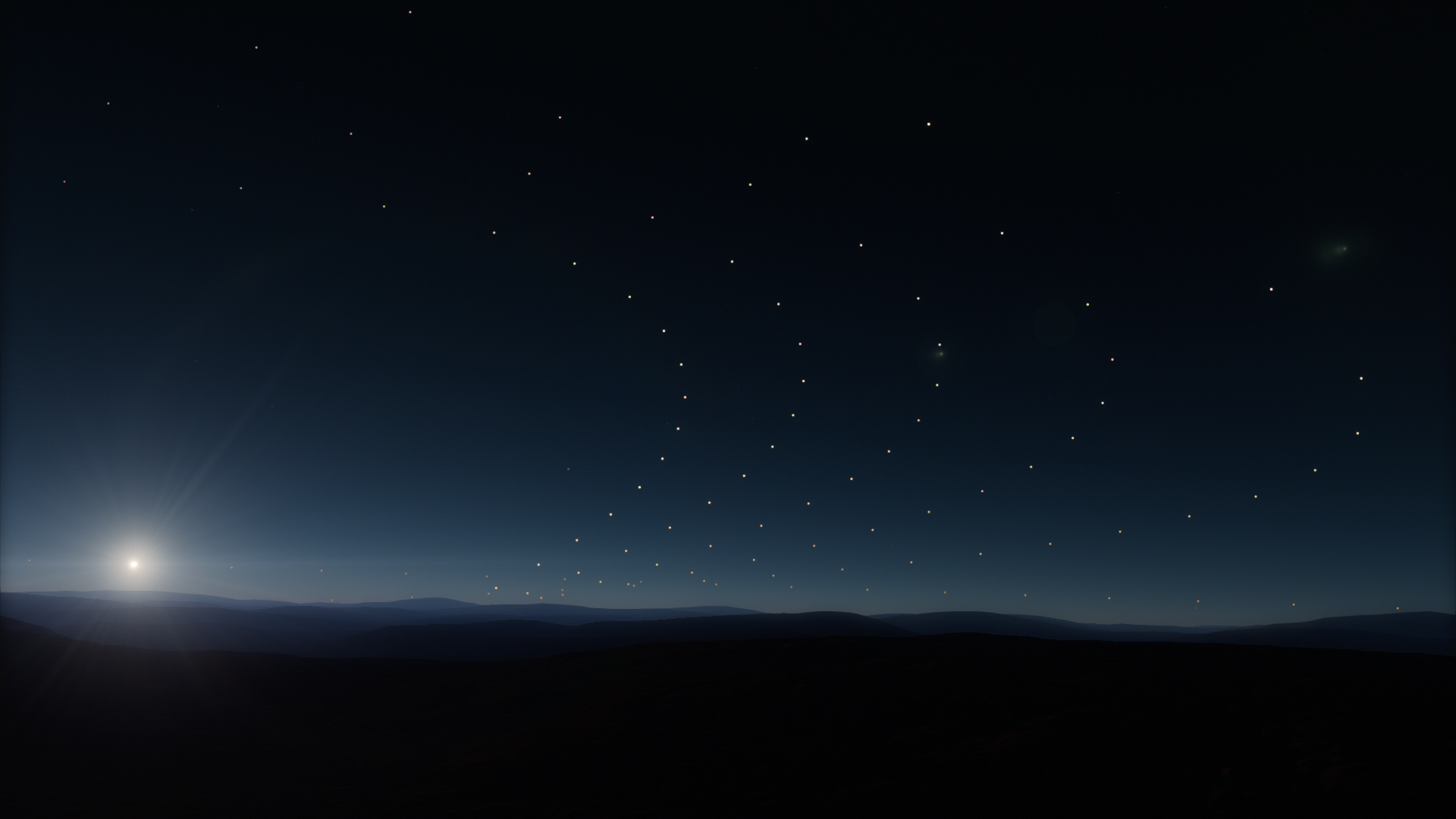
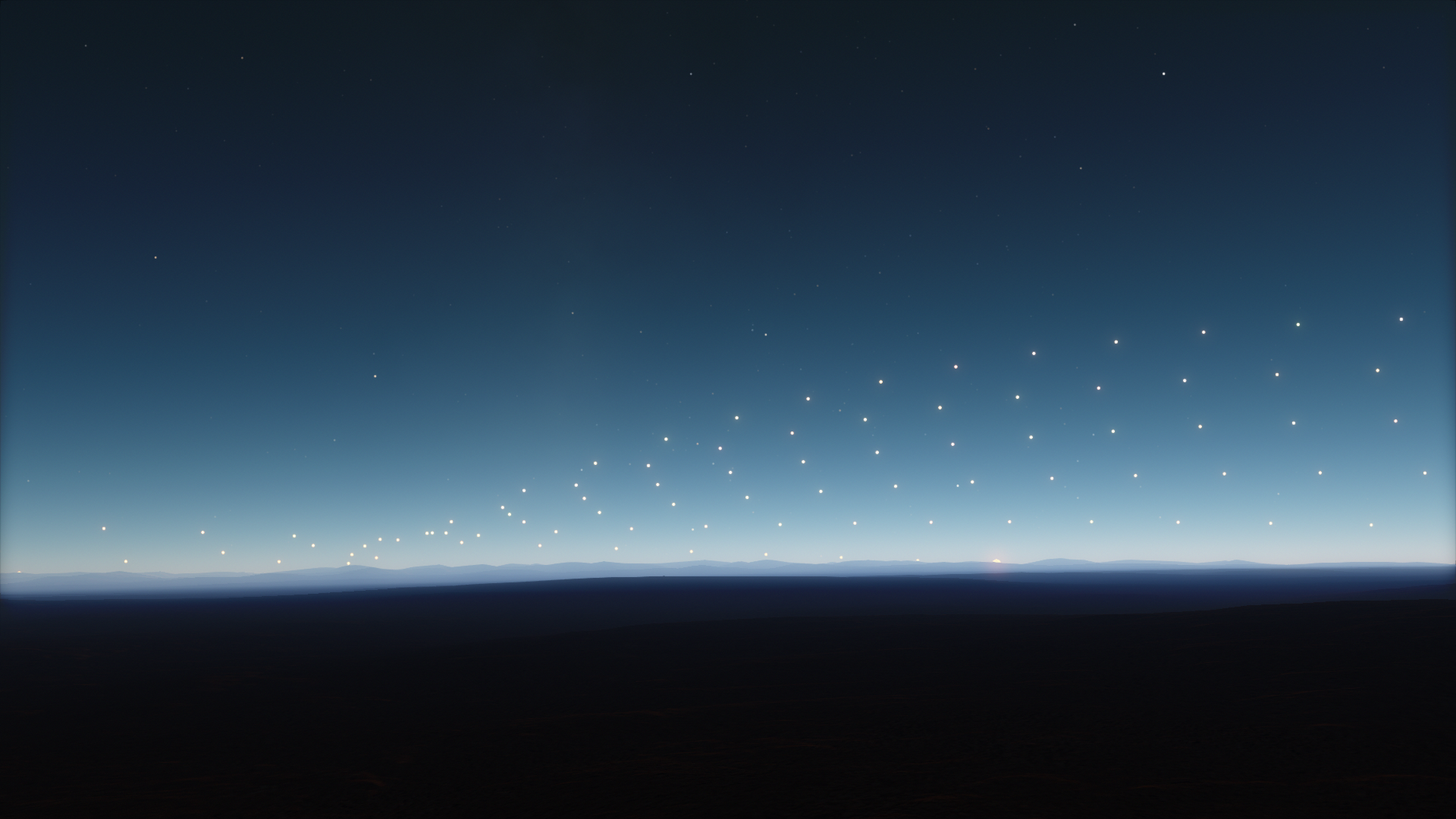
earth-like --ring-gap=0.01 --inclination-delta=5
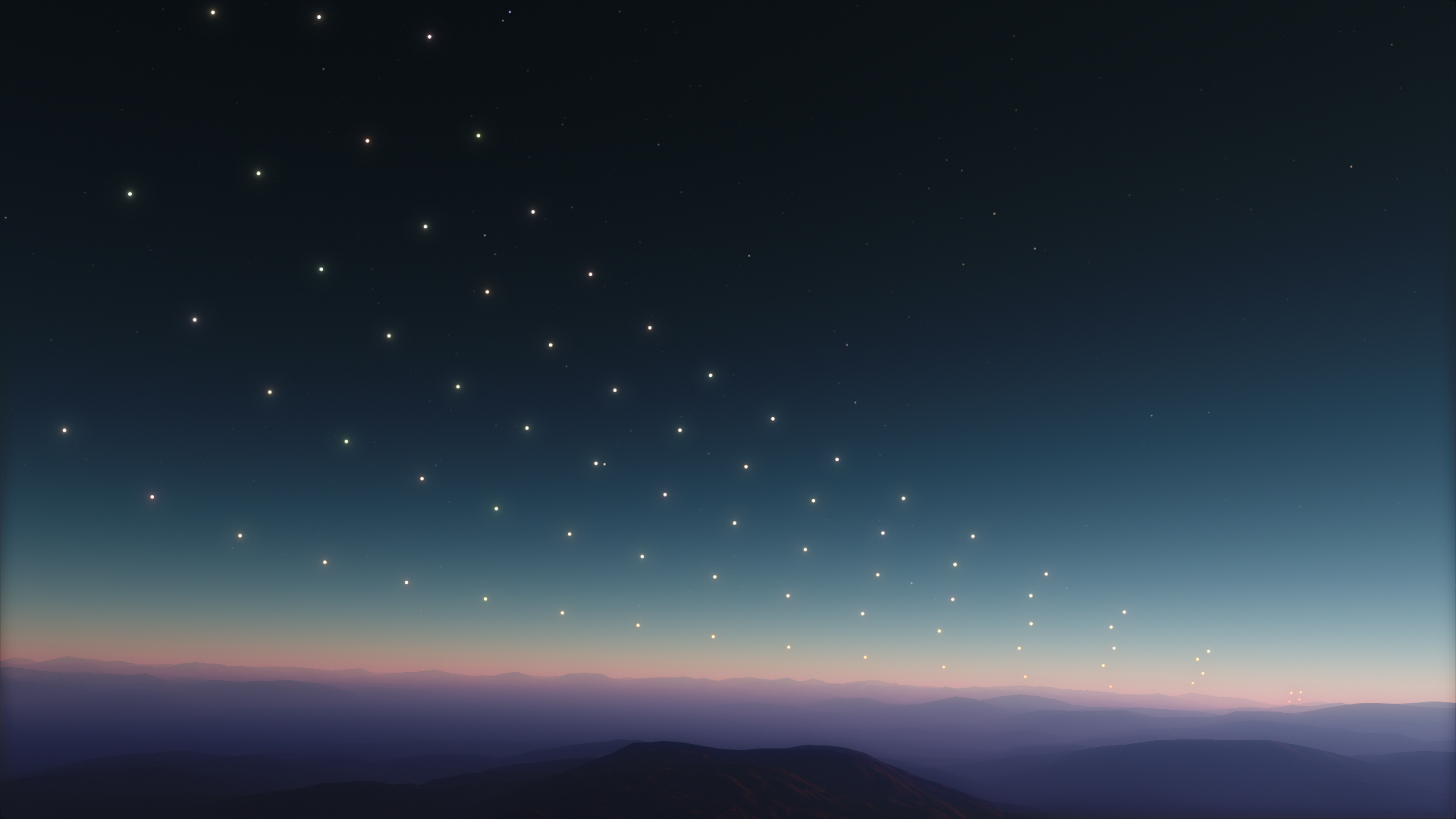
earth-like --inclination-delta=5
The ballet, the sunset and the speck
I also recorded a video, taken with recordMyDesktop, showing both the system's movement, a sunset view from outer planets, a night sky from an inner one, and an eclipse.
(used police is from the famous Some Time Later)
The path to the good
Many things are lacking in this visualization. The most important thing is probably the mathematic coherence behind: planet exact size & mass, real habitability zone of the star, and therefore distances between rings…
All these parameters are currently tweaked without real consistencies, and most of visualizations i show here use a very large ring gap, leading to really cold planets.
So, this deserve some further study.
To obtain a temperate-instead-of-cool terra (an effective temperature around 0°C) in the system, i had to tweak the star:
Remove "RS 1228-511-0-0-320"
Star "RS 1228-511-0-0-320/EngineeredSystemStar"
{
RA 16 10 45 // right ascension
Dec -25 12 11 // declination
Dist 100.0 // distance from the Sun
Class "G3V" // spectral class
Lum 1.2 // luminosity, or
RadSol 1 // radius in Solar radii
MassSol 1 // mass in Solar masses
Teff 6600 // surface temperature in Kelvin
NoPlanets true
}
To (sort of) prove the viability of the system, a good indicator could be life. I do not know the algorithm running the decision of life presence in Space Engine, but i do know that, on more than 200 earth-like planets, none got life, probably because of all parameters i didn't look at.
Or maybe that is just because life appears very rarely, whatever how good the conditions are.
The conclusive conclusion
When reading Sean Raymond's blog articles, the idea of rendering it using Space Engine come very quickly. I thought it would be complex, and maybe unfeasible because of the amount of objects in the system.
Well, i was wrong. Not only Space Engine is fully able to render 1257 planets and their star, but it can be done in few lines of code and time, to finally provides pretty views of the full system, from any vantage point.
Space Engine is awesome. Sean Raymond's job is awesome. My new wallpapers are awesome.
Now, you're turn !
You have Space Engine. You have the sources. You have ideas.
You can take beautiful screenshots of the system, tweaks it to get a different organization, enrich it with moons or additionnal stars, improve the code, the SE scripts, the planets generation, or study the equations, or generate a Carl Sagan-like voice that tells the story of the UESS, or anything else…
The repository is open to PR, issues, and i'm open to mails.
Links
- Sean Raymond's blog series
- Space Engine
- Space Engine subreddit
- Space Engine documentation for addons
- exoplanets listing and distribution
- contribute to the UESS visualization
- spaceengine python package: an attempt to modelize and generate systems for Space Engine